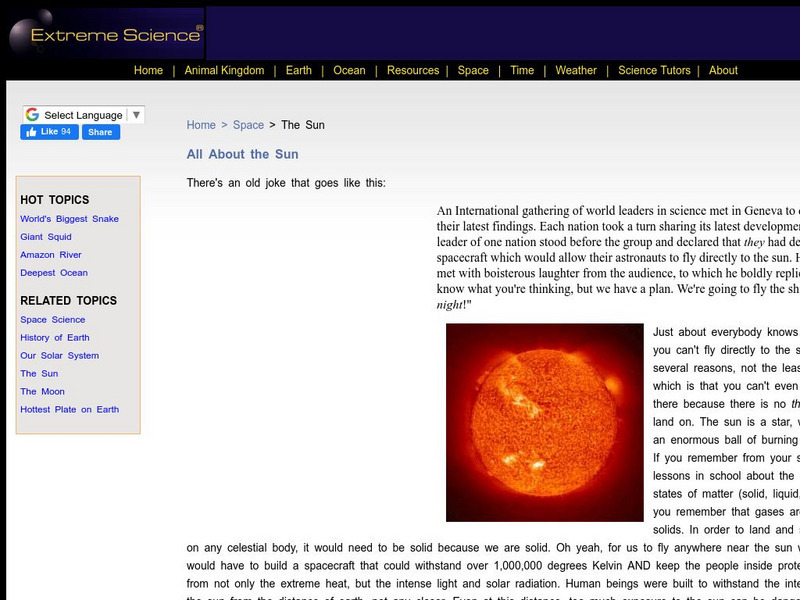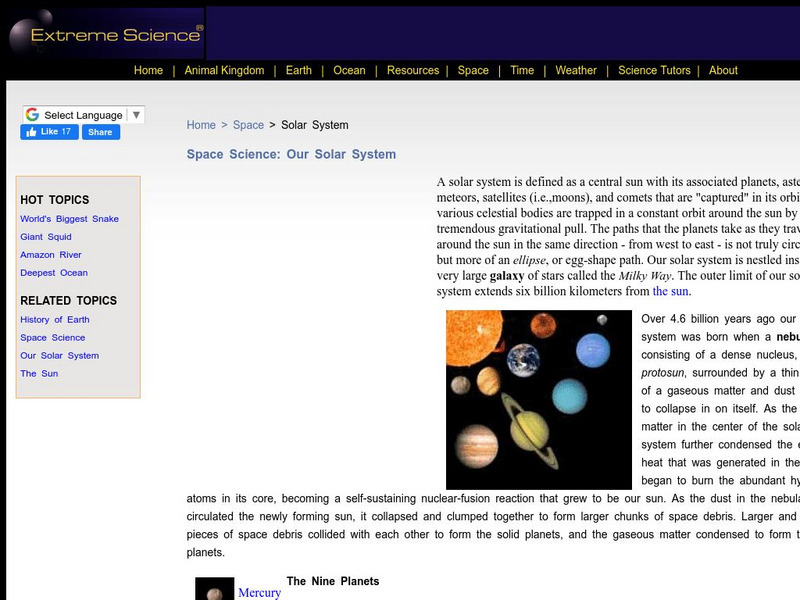University of Texas at Austin
The University of Texas Mc Donald Observatory: Pluto
Discover interesting information about Pluto, a member of the Kuiper Belt and no longer a planet since 2006.
University of Texas at Austin
The University of Texas Mc Donald Observatory: Saturn
Discover interesting facts about Saturn, the second-largest planet in the Solar System.
University of Texas at Austin
The University of Texas Mc Donald Observatory: Solar System Science
Each student becomes the "ambassador" for a planet and prepares by researching their planet, then meets with other ambassadors to form new mini-solar systems.
University of Texas at Austin
The University of Texas Mc Donald Observatory: Rock Cycle
This activity combines the concept of Earth's rock cycle with the characteristics of other planets in the solar system.
University of Texas at Austin
The University of Texas Mc Donald Observatory: Asteroids
Discover interesting facts about asteroids, large chunks of rock that were leftover from the formation of the solar system.
University of Texas at Austin
The University of Texas Mc Donald Observatory: Meteorites
Discover fascinating facts about meteorites, pieces of asteroids that originate in outer space and survives their passage through the atmosphere to reach the ground.
University of Texas at Austin
The University of Texas Mc Donald Observatory: Comets
Discover interesting facts about comets, an icy time capsule left over from the birth of planets.
University of Texas at Austin
The University of Texas Mc Donald Observatory: Earth
Learn interesting information about the Earth, the largest of the "terrestrial" planets.
University of Texas at Austin
The University of Texas Mc Donald Observatory: Sunspots
Experiment involves identifying sunspots, temporary phenomena on the Sun's photosphere that appear as spots darker than the surrounding areas.
Science Buddies
Science Buddies: Kinesthetic Astronomy: Longer Days, Shorter Nights
This kinesthetic activity demonstrates to young scholars that the Earth's tilt is what is responsible for shifting light patterns and the change in seasons.
Ohio State University
Osu History Teaching Institute: The Trial of Galileo
Young scholars will become familiar with the Trial of Galileo Galilei, will understand who Galileo was, and how the controversy around his ideas about the solar system reflected the conflict of ideas in a time of change.
Science Buddies
Science Buddies: Stargazing for Satellites
Did you know you can see many satellites with the naked eye? Try this activity and find out for yourself!
NASA
Nasa Space Place: What Is a Comet?
Provides a brief description of comets, where they come from, and the different parts that make up a comet.
NASA
Nasa Space Place: All About Neptune
Learn fascinating facts about Neptune, the last of the planets in our solar system.
NASA
Nasa Space Place: All About Uranus
Discover interesting facts about the planet Uranus and what it looks like.
Utah Education Network
Uen: Composition of the Solar System
Students will use a reading selection to compare the solar system to a neighborhood and do some writing, drawing and make comparisons to reinforce their knowledge about the rocky planets, gas giants and amount of matter in the solar system.
University Corporation for Atmospheric Research
Ucar: The Sun
Learn about the sun, the center of our solar system and the closest star to Earth.
Extreme Science
Extreme Science: All About the Sun
Read about the sun, the source of its energy, solar activity, sunrise/sunset times, solar flares, and other interesting facts.
Australian Broadcasting Corporation
Australian Broadcasting Corporation: News in Science: Comets Collide as Star System Dies
From ABC News in Science, Larry O'Hanlon's article examines scientific evidence which suggests that the death of our solar system will be linked to the collision of comets.
Extreme Science
Extreme Science: Space Science: Our Solar System
Read about our solar system and its formation over 4.6 billion years ago. Find out about the planets, asteroids, meteors, satellites, and comets. More in-depth planet background can be accessed through links.
Cosmo Learning
Cosmo Learning: Introduction to Astrophysics
A collection of audio lectures from an introduction to astrophysics course taught at the University of California, Berkeley. The course discusses the solar system, stars, quantum mechanics, gravitation, and cosmology focusing on how...






